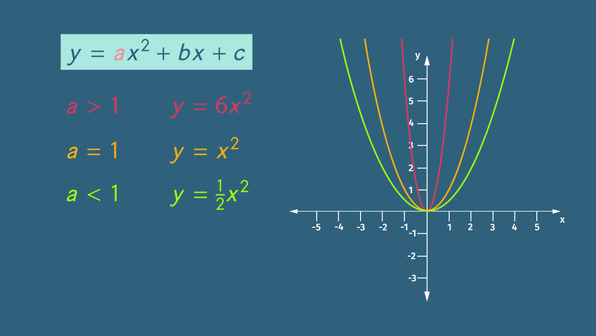
Solving Quadratic and Cubic Equations: A Step-by-Step Guide
Introduction
Quadratic and cubic equations are fundamental in algebra and appear in various real-world applications. A quadratic equation is of the form ax2 +bx+c= 0, while a cubic equation is of the form ax3 +bx2 +cx+ d = 0. In this article, we will explore different methods to solve these equations, with clear explanations for each step.
Solving Quadratic Equations
A quadratic equation is of the form:
ax2 + bx + c = 0 (a = 0)
There are several methods to solve quadratic equations: factoring, completing the square, and using the quadratic formula.
Method 1: Factoring
Factoring is the simplest method when the quadratic can be expressed as a product of two binomials.
Steps:
- Write the equation in standard form: ax2 + bx + c = 0.
- Factor the quadratic into two binomials: (px + q)(rx + s) = 0(Many times in such a case, we can factor c into multiples and try to find two multiples m,n such that m + n = b. Then break b into m,n and try to being the form as in the next step).
- Set each binomial equal to zero and solve for x:
px + q = 0 or rx + s = 0
4. The solutions are:
x = −p and x = −r
Example: Solve x2 − 5x + 6 = 0. We note before starting the solution that 6 = (−3)(−2) and (−3) + (−2) = (−5) = b
x2 − 5x + 6 = 0
x2 − 3x − 2x + 6 = 0
(x − 2)(x − 3) = 0
x − 2 = 0 or x − 3 = 0
x = 2 or x = 3
Method 2: Completing the Square
Completing the square is a method that works for all quadratic equations.
Steps:
- Write the equation in standard form: ax2 + bx + c = 0.
Divide both sides by a (if a = 1): x2 + b x + c = 0.
- Move the constant term to the other side: x2 + b x = − c .
a a
| 2a |
Add b 2 to both sides to complete the square:
x2 + b x +
a
b 2 c
| — |
= +
2a a
b 2
2a
- Rewrite the left side as a perfect square:
| x +2a |
b 2
| = |
b2 − 4ac
- Take the square root of both sides:
- Solve for x:
b
x + 2a = ±
b2 − 4ac 4a2
| r |
√ 2
Example: Solve x2 − 4x − 5 = 0.
b
x = − 2a ±
b − 4ac
2a
x2 − 4x = 5
x2 − 4x + 4 = 5 + 4 (Add (x − 2)2 = 9
x − 2 = ±3
x = 2 ± 3
−4 2
= 4)
x = 5 or x = −1
Method 3: Quadratic Formula
The quadratic formula is a universal method for solving any quadratic equation.
Formula:
Steps:
x = −b ±
| √ |
b2 − 4ac
2a
- Identify a, b, and c in the equation ax2 + bx + c = 0.
- Substitute these values into the quadratic formula.
- Simplify under the square root (the discriminant).
- Calculate the two solutions using + and −.
Example: Solve 2x2 + 4x − 6 = 0.
a = 2, b = 4, c = −6
−4 ± √42 − 4(2)(−6)
x =
2(2)
| 4 |
x = −4 ± √16 + 48
x = −4 ± √64
4
x = −4 ± 8
4
x = 1 or x = −3
Solving Cubic Equations
A cubic equation is of the form:
ax3 + bx2 + cx + d = 0 (a = 0)
Solving cubic equations is more complex than solving quadratics. Here, we will discuss the Rational Root Theorem and synthetic division.
Method 1: Rational Root Theorem
The Rational Root Theorem helps identify possible rational roots of a polynomial equation.
Steps:
- List all factors of the constant term d and the leading coefficient a.
| factor of a |
The possible rational roots are of the form factor of d .
- Test these possible roots by substituting them into the equation.
- Once a root r is found, factor the polynomial as (x − r) · Q(x), where Q(x) is a quadratic.
- Solve the quadratic equation Q(x) = 0 using methods for quadratics. Example: Solve x3 − 6x2 + 11x − 6 = 0.
| 2 |
Possible roots = ±1, ±2, ±3, ±6 Test x = 1 : 1 − 6 + 11 − 6 = 0 (Root found) Factor: (x − 1)(x − 5x + 6) = 0
Solve x2 − 5x + 6 = 0 (x − 2)(x − 3) = 0
x = 1, 2, 3
Method 2: Synthetic Division
Synthetic division is a shortcut for dividing polynomials when a root is known.
Steps:
- Identify a root r using the Rational Root Theorem.
- Use synthetic division to divide the polynomial by (x − r).
- Rewrite the polynomial as (x − r) · Q(x).
- Solve the quadratic equation Q(x) = 0.
Example: Solve x3 − 4x2 + x + 6 = 0.
Possible roots = ±1, ±2, ±3, ±6
Test x = 2 : 8 − 16 + 2 + 6 = 0 (Root found) Synthetic division:
2 1 −4 1 6
2 −4 −6
1 −2 −3 0
Factor: (x − 2)(x2 − 2x − 3) = 0
Solve x2 − 2x − 3 = 0 (x − 3)(x + 1) = 0
x = 2, 3, −1
1 Vieta’s formula to solve quadratic’s and cubic’s :
Vieta’s formulas provide a powerful tool for solving polynomial equations by establishing relationships between the coefficients and the roots of the equation. These formulas are particularly useful for quadratic and cubic equations, as they allow us to determine the roots without explicitly factoring the polynomial. Let us explore this step by step.
Quadratic Equations
Consider a general quadratic equation of the form:
ax2 + bx + c = 0,
where a = 0. If the roots of this equation are α and β, Vieta’s formulas state that:
b
α + β = −a (Sum of the roots),
c
αβ =
a
(Product of the roots).
| − − |
These relationships arise from expanding the factored form of the quadratic equation, a(x α)(x β) = 0, and comparing coefficients. To solve for the roots, we can use these formulas as follows:
| a |
Compute the sum of the roots, α + β, using − b .
| a |
Compute the product of the roots, αβ, using c .
- Find two numbers that satisfy both the sum and product conditions. For example, if α + β = 5 and αβ = 6, the roots are 2 and 3, since 2 + 3 = 5 and 2 · 3 = 6.
Cubic Equations
For a general cubic equation of the form:
ax3 + bx2 + cx + d = 0, where a = 0, if the roots are α, β, and γ, Vieta’s formulas extend to:
b
α + β + γ = −a (Sum of the roots),
c
αβ + αγ + βγ =
a
(Sum of the products of the roots taken two at a time),
d
αβγ = −a (Product of the roots).
| − − − |
These relationships are derived from expanding the factored form a(x α)(x β)(x γ) = 0 and comparing coefficients. To solve for the roots, follow these steps:
| a |
Compute the sum of the roots, α + β + γ, using − b .
| a |
Compute the sum of the products of the roots taken two at a time, αβ + αγ + βγ, using c .
| a |
Compute the product of the roots, αβγ, using −d .
- Use these values to construct a system of equations and solve for α, β, and γ. For example, if α + β + γ = 6, αβ + αγ + βγ = 11, and αβγ = 6, the roots are 1, 2, and 3, since they satisfy all three conditions.
Key Insights
Vieta’s formulas are particularly useful because they allow us to work directly with the symmetric sums and products of the roots, bypassing the need for explicit factoring. This method is especially helpful when the roots are integers or simple fractions, as it reduces the problem to solving a system of equations. For more complex roots, Vieta’s formulas can still provide valuable insights into the relationships between the roots and coefficients, even if additional techniques (such as the quadratic or cubic formula) are required to find the exact values.
Conclusion
Solving quadratic and cubic equations requires understanding different methods and practicing them. For quadratics, factoring, completing the square, and the quadratic formula are effective. For cubics, the Rational Root Theorem and synthetic division are useful tools. With practice, these methods become intuitive and powerful for solving polynomial equations.





